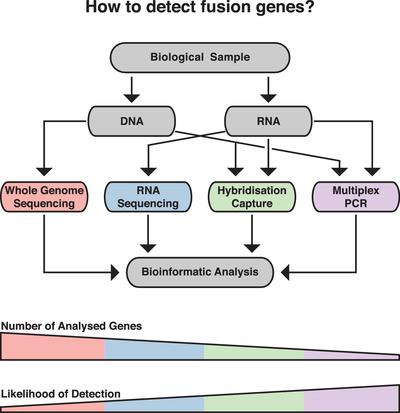Our official English website, www.x-mol.net, welcomes your feedback! (Note: you will need to create a separate account there.)
Sequencing Strategies for Fusion Gene Detection
BioEssays ( IF 4 ) Pub Date : 2020-04-19 , DOI: 10.1002/bies.202000016 Erin E. Heyer 1 , James Blackburn 1, 2
BioEssays ( IF 4 ) Pub Date : 2020-04-19 , DOI: 10.1002/bies.202000016 Erin E. Heyer 1 , James Blackburn 1, 2
Affiliation

|
Fusion genes formed by chromosomal rearrangements are common drivers of cancer. Recent innovations in the field of next‐generation sequencing (NGS) have seen a dynamic shift from traditional fusion detection approaches, such as visual characterization by fluorescence, to more precise multiplexed methods. There are many different NGS‐based approaches to fusion gene detection and deciding on the most appropriate method can be difficult. Beyond the experimental approach, consideration needs to be given to factors such as the ease of implementation, processing time, associated costs, and the level of expertise required for data analysis. Here, the different NGS‐based methods for fusion gene detection, the basic principles underlying the techniques, and the benefits and limitations of each approach are reviewed. This article concludes with a discussion of how NGS will impact fusion gene detection in a clinical context and from where the next innovations are evolving.
中文翻译:

融合基因检测的测序策略
由染色体重排形成的融合基因是癌症的常见驱动因素。下一代测序(NGS)领域的最新创新已从传统的融合检测方法(例如通过荧光进行视觉表征)向更精确的多重方法动态转变。有许多基于NGS的融合基因检测方法,很难确定最合适的方法。除了实验方法之外,还需要考虑诸如易于实施,处理时间,相关成本以及数据分析所需的专业知识水平等因素。在此,对基于NGS的融合基因检测的不同方法,该技术的基本原理以及每种方法的优缺点进行了综述。
更新日期:2020-04-19
中文翻译:

融合基因检测的测序策略
由染色体重排形成的融合基因是癌症的常见驱动因素。下一代测序(NGS)领域的最新创新已从传统的融合检测方法(例如通过荧光进行视觉表征)向更精确的多重方法动态转变。有许多基于NGS的融合基因检测方法,很难确定最合适的方法。除了实验方法之外,还需要考虑诸如易于实施,处理时间,相关成本以及数据分析所需的专业知识水平等因素。在此,对基于NGS的融合基因检测的不同方法,该技术的基本原理以及每种方法的优缺点进行了综述。



























 京公网安备 11010802027423号
京公网安备 11010802027423号